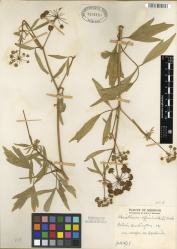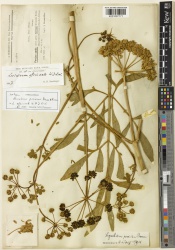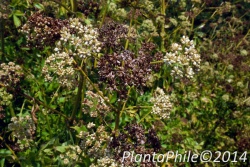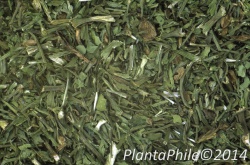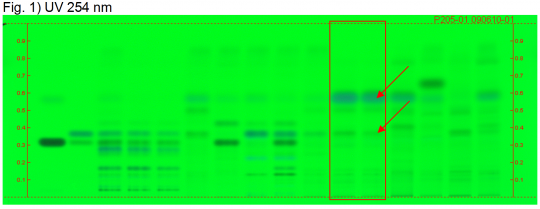Levisticum officinale (root)
(Various title corrections, Source additions) |
(add Kew voucher specimen reference) |
||
| (3 intermediate revisions by 2 users not shown) | |||
| Line 1: | Line 1: | ||
| − | {{DISPLAYTITLE:''Levisticum officinale'' (root) }} | + | {{DISPLAYTITLE:''Levisticum officinale'' (root) }} {{askbox|herb=''Levisticum officinale''}} |
=Nomenclature= | =Nomenclature= | ||
| Line 13: | Line 13: | ||
=Botanical Voucher Specimen= | =Botanical Voucher Specimen= | ||
| + | |||
| + | {{Media2 |cat=Voucher | ||
| + | |||
| + | | source=MOBOT, Tropicos.org | ||
| + | | mainimage=Levisticum_officinale_Tropicos_88150.jpg | ||
| + | | companyimage=TropicosLogo.gif | ||
| + | | companyURL=http://www.tropicos.org/Image/88150 | ||
| + | | reference=Tropicos.org. Missouri Botanical Garden. 25 Mar 2014 <http://www.tropicos.org/Image/88150> | ||
| + | |||
| + | | companyimage2=Kewlogo.gif | ||
| + | | companyURL2=http://specimens.kew.org/herbarium/K001097171 | ||
| + | | image2=Levisticum officinale Kew barcode=K001097171 717110.jpg | ||
| + | | source2=Royal Botanic Gardens, Kew. | ||
| + | | }} | ||
| + | |||
=Organoleptic Characteristics= | =Organoleptic Characteristics= | ||
=Macroscopic Characteristics= | =Macroscopic Characteristics= | ||
| + | {{ Media2 | cat=Macroscopy | ||
| + | | source=PlantaPhile | ||
| + | | mainimage=PlantaPhile - 129.jpg | ||
| + | | companyimage=PlantaPhile logo.jpg | ||
| + | | companyURL=http://plantaphile.com/ | ||
| + | |||
| + | | source2=PlantaPhile | ||
| + | | image2=PlantaPhile - 2656.jpg | ||
| + | | companyimage2=PlantaPhile logo.jpg | ||
| + | | companyURL2=http://plantaphile.com/ | ||
| + | | }} | ||
=Microscopic Characteristics= | =Microscopic Characteristics= | ||
Latest revision as of 14:48, 26 May 2015
Contents |
Nomenclature
Levisticum officinale W. Koch Apiaceae
Standardized common name (English): lovage
Botanical Voucher Specimen
 |
|
|
|
|
Organoleptic Characteristics
Macroscopic Characteristics
|
|
|
Microscopic Characteristics
High Performance Thin Layer Chromatographic Identification
|
Lovage (root) (Levisticum officinale) Lane Assignments Lanes, from left to right (Track, Volume, Sample):
Reference Sample(s) Reference: Dissolve 1 mg each of osthole and imperatorin in 10 mL of methanol. Optional: Dissolve 1 mg of Z-ligustilide in 10 mL of methanol. Stationary Phase Stationary phase, i.e. Silica gel 60, F254 Mobile Phase Toluene, ethyl acetate, glacial acetic acid 90:10:1 (v/v/v) Sample Preparation Method Sample: Mix 1.0 g of powdered sample with 4 mL of heptane and sonicate for 5 minutes, then centrifuge and filter the solutions and use the filtrates as test solutions. Derivatization reagent: Sulfuric acid reagent, Preparation: 20 mL sulfuric acid with 180 mL methanol, Use: Dip for 1 s, heat at 100°C for 5 min. Detection Method Saturated chamber; developing distance 70 mm from lower edge; relative humidity 33% Other Notes Images presented in this entry are examples and are not intended to be used as basis for setting specifications for quality control purposes. System suitability test: Imperatorin: greenish fluorescent zone at Rf ~ 0.31 (UV 366 nm); Osthole: blue fluorescent zone at Rf ~ 0.36 (UV 366 nm). Identification: Compare result with reference images. The fingerprint of the test solution is similar to that of the corresponding botanical reference sample. Additional weak zones may be present. Under UV 254 nm the chromatogram of the test solution shows an intense blue fluorescent zone at Rf ~ 0.57 and a weak quenching zone corresponding to reference osthole (Rf ~ 0.36) (red arrows). Under UV 366 nm the chromatogram of the test solution shows an intense blue white fluorescent zone at Rf ~ 0.57 and a weak whitish fluorescent zone with similar Rf-value as reference imperatorin (yellow arrows). After derivatization under white light there are two prominent purple zones below the solvent front. Below reference imperatorin there are two distinct purple zones and below them is an intense greenish zone. Test for adulteration: Under UV 254 nm no zone is seen at or directly below the position of imperatorin. Under UV 366 nm there is no zone at the position of osthole. After derivatization under white light there are no zones at the position of imperatorin and osthole and just below the position of imperatorin there is no prominent diffuse purple zone (red arrow) (Angelica root, Chinese Angelica root, Doubleteeth pubescent root, Dahurian Angelica root, Chinese Lovage root). Source: HPTLC Association [5] |
Supplementary Information
Sources
- ↑ MOBOT, Tropicos.org http://www.tropicos.org/Image/88150
- ↑ Royal Botanic Gardens, Kew. http://specimens.kew.org/herbarium/K001097171
- ↑ PlantaPhile http://plantaphile.com/
- ↑ PlantaPhile http://plantaphile.com/
- ↑ HPTLC Association http://www.hptlc-association.org/
